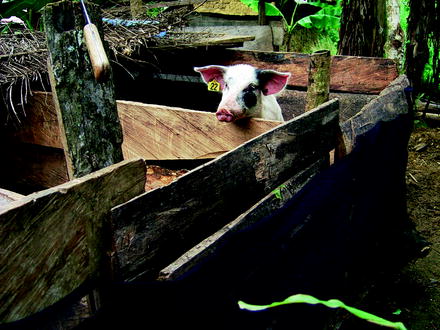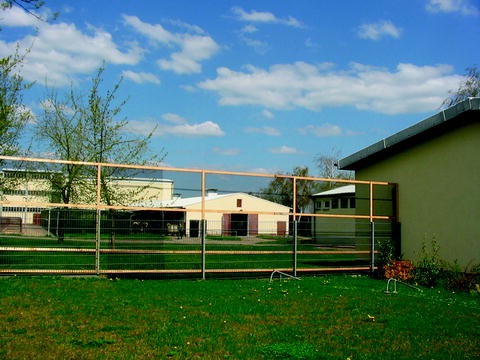Fig. 6.1
Insecticide-treated polyester fences protect cattle on the Boadi Cattle Farm in Kumasi, Ghana, 2005. The 1-m-high net consisted of black multi-filament polyester with a mesh width of 1 × 2 mm, pre-treated with deltamethrin (100 mg/m2) and a UV protector
Further confirmation of these effects was sought in another field study of peri-urban areas in Burkina Faso and Mali (Lassane et al. 2011) where improved livestock husbandry systems are maintained for dairy production. As in the previous study in Kumasi, a pre-treated multi-filament polyester net was attached to existing poles of the units containing cattle. Unprotected units served as controls. Densities of nuisance insects outside each pen were evaluated with mono-conical Vavoua traps. Mosquitoes were monitored with battery-driven BG traps (BioGents®sentinel traps; Rose et al. 2006). Distinct differences were recorded at the onset of the rainy season with significant increases of nuisance insects and mosquitoes in the vicinity of unprotected units, whereas the numbers of insects collected in the vicinity of protected units only showed insignificant increases.
Another study was conducted in two villages in the Eastern Region of Ghana where the national veterinary services had identified tsetse-transmitted trypanosomosis as the leading cause for sudden pig mortalities during April 2007 (Bauer et al. 2011).
Two villages were selected—one serving as control with 14 pigsties and one experimental village where 28 pigsties were protected with the netting material which had also been used during the previous trials in West Africa. The material was attached to surrounding timber poles and planks (Fig. 6.2). Bi-monthly monitoring of tsetse densities with ten geo-referenced bi-conical traps (Challier et al. 1977) per village showed a reduction of more than 90% in the protected village within 2 months. Further reductions exceeding 95% were recorded during subsequent months. The tsetse population in the control village remained unaffected, only displaying seasonal variations.


Fig. 6.2
Insecticide-treated polyester fences protect pigsties in the Eastern Region of Ghana, 2007. The 1-m-high net consisted of black multi-filament polyester with a mesh width of 1 × 2 mm, pre-treated with deltamethrin (100 mg/m2) and a UV protector
The initial trypanosome prevalence, as assessed by thin blood smears, amounted to 76% and 72% of protected and control animals, respectively, and decreased to 16% in protected as opposed to 84% in control pigs 3 months after intervention. After 6 months, 8% of the protected pigs were infected contrasting with 60% in the control group. The results are a further confirmation of the efficacy of ITN, enabling farmers to keep their livestock alive in an area deemed unsuitable for livestock production because of high tsetse densities and the ensuing trypanosome risk. Bio-assays with susceptible Musca domestica showed a persistency of the ITN exceeding 8 months under tropical climate conditions.
Kagbadouno et al. (2011) reported in another tsetse control operation on Loos islands in Guinea-Conakry more than 90% reduction of the initial population following the use of ITN.
6.3 Studies in Europe
Since the principles of insect behaviour (horse and nuisance flies in this case) also apply for these insects in moderate climate, a study was undertaken in north-western Brandenburg to assess the efficacy of ITN protecting horses against attacks from biting and nuisance insects during the grazing period of summer 2004 (Bauer et al. 2006b). The ITN corresponded to the material previously used in Africa. The net was attached to the outside of already existing fences at a height of about 100 cm above ground. Three groups of horses that were kept on spatially separated pasture were retained for the trial. The first group consisted of mares and foals, serving as unprotected control. The second group was kept on a paddock that was fully protected. The third group, consisting of stallions, was partially protected, where only 13.4% of the total perimeter had been fenced. Fly densities were monitored with four Nzi traps outside each pasture. Fly catches showed a distinct reduction: when compared with the control area, the reduction was 67% outside the paddock (complete protection) and 57% in the vicinity of the enclosure for the stallions (partial protection). Recording of the attack rates of individual horses by flies with a digital camera on five different anatomical body regions (eye, neck, back, lateral and lower chest) revealed significant differences. Compared with the control, the attack rates of individual horses were reduced by 97% in the paddock and by 96%, respectively, of the horses kept on the partially protected pasture.
Following the outbreak of bluetongue (BTV-8) in many parts of north-western Europe and in Germany, efforts were undertaken to curb the spread of the disease, particularly in farms with valuable livestock, as on a stud bull farm in Schmergow, Brandenburg, Germany. Due to the abundance of Culicoides species, the putative BTV vectors, several control methods were applied, aiming at a reduction of the target insect populations. Insecticide-impregnated ear tags and regular treatments at 6 weeks intervals of all bulls with deltamethrin pour on were expected to achieve the intended reduction of biting midges. Since the trial results in Ghana (Maia et al. 2010) indicated an impact of the 1-m-high ITN on Culicoides spp., it was for the first time tried to control midges by using an incomplete ring of a 1.80-m-high fence protecting about 80% of the premises (Bauer et al. 2009). The net corresponded to the already described material. After an initial but only temporary reduction from more than 7,000 to below 500 midges—two BioGents® sentinel traps (Rose et al. 2006) had been used for measuring midge densities—the catches returned to their pre-intervention level. The transitory reduction could have been attributed to an initial protective effect of the fence or—what could not be excluded—to unfavourable weather conditions impairing the midges’ activity for 2 weeks after deployment of ITN. It was also shown from microscopic examinations of midges and other haematophagous mosquitoes (Aedes and Anopheles spp.) that despite regular treatments of the bulls at 6 weeks intervals with a pour on formulation of deltamethrin and the simultaneous use of insecticide-impregnated ear tags, a high percentage of the target insects succeeded to feed. Between 10 and 35% of Culicoides spp. and more than 50% of Aedes and Anopheles spp., respectively, had engorged on the treated bulls. These observations illustrate the need for further R&D to identify more efficient control methods for midges and mosquitoes. It is also obvious that the modern structures of today’s farms do not offer shelter against midges; hence, the recommended housing of valuable livestock will not prevent the midges from entering and feeding and, eventually, transmitting BTV (Clausen et al. 2009). Indoor survival of both Culicoides spp. as well as Aedes and Anopheles spp. cannot be excluded, transmission of BTV—albeit at a lower level—may continue during winter.
Building on the expertise acquired during the studies on the stud bull farm in Schmergow, a new approach was adopted, using—after further R&D—a different netting material in 2009. The fence consisted of black multi-filament polyester with a mesh width of 1.5 × 1.7 mm, pre-treated with micro-encapsulated deltamethrin (90 mg/m2) and a UV protector. This new ITN prototype was used to protect—at a height of 3 m—the stud bull farm in Schmergow (Fig. 6.3) and also to protect with an incomplete ring (80%)—at 2 m height—zero-grazed cattle on a dairy farm in Lögow, Brandenburg. The incomplete ring allowed for daily operation procedures on the farm. A second unit served as a control. It was shown for the first time that the use of ITN resulted in significant reductions of Culicoides spp. on both farms during the trials. Structure of the net and mode of attachment ensured that the fence remained largely in place despite frequent gales during autumn 2009 and spring 2010. Chemical analyses of the amount of active ingredient (AI) allowed monitoring of an eventual, time-dependent decrease of deltamethrin. The loss of not more than 40–50% of the active ingredient after 1 year corroborates the results of the bio-assays. When exposed in a test box® (Patent No. 08803541.5 – 1260 PCT/EP 2008061570) for 10 s, susceptible M. domestica were still paralysed after more than 400 days of exposure of the netting material to the prevailing climate. Both laboratory-reared C. nubeculosus as well as wild-caught C. obsoletus were killed when alighting on or crossing the net even after short contacts for a few seconds (Manti et al. 2010). Catches with three BioGents® sentinel traps each and two Glue-Fly Ribbon Traps per pen showed significant reductions of Culicoides spp. and nuisance flies, particularly Stomoxys calcitrans (Skrock 2011). In comparison to the control building, midges were reduced by 41.9% (p = 0.0391), and nuisance flies, by 77.2% (p = 0.0039).


Fig. 6.3
Insecticide-treated polyester fences protect a stud bull farm in Schmergow, Brandenburg, Germany, 2009 (Rinderproduktion Berlin-Brandenburg (RBB)). The 3-m-high net consisted of black multi-filament polyester with a mesh width of 1.5 × 1.7 mm, pre-treated with micro-encapsulated deltamethrin (90 mg/m2) and a UV protector
Automatic recordings of defensive movements/dairy cows showed significantly fewer reactions in the protected pen due to the reduction of S. calcitrans. In turn, this resulted in a significant increase (1.2 kg/cow/day) of milk yield (Peters 2011). These observations are in line with previous work by Campbell et al. (1987) and Gerry et al. (2007), where it was found that five S. calcitrans/leg constitute an abundance value (= economic injury threshold) entailing unacceptable economic and/or health costs. In another paper, Mullens et al. (2006) suggested to evaluate fly-repelling behaviour, postulating that an average of 10 or more tail flicks/min would be equivalent to 5 stable flies/leg.
Environmental studies of beneficial arthropods (indicator species) showed that, for instance, bees (hymenoptera) or hovering flies (Syrphidae) were not or only negligibly affected.
Eco-toxicity of ITN was analysed in samples of milk, meat, faeces, soil and groundwater (no threshold value), indicating that these values were not attained (Frenzel 2011).
Calvete et al. (2010) studied in Spain the efficacy of surrounding yearling ewe pens with an untreated canvas barrier compared to a cypermethrin-treated canvas barrier to reduce the entry of Culicoides spp. and C. imicola in particular in the southwest of Spain. Analyses were based on comparisons of Culicoides catches in traps in pens with and without barriers, and in traps located outside pens. Although there was no clear reduction in the abundance of Culicoides other than C. imicola in pens with either barrier, the C. imicola presence was markedly reduced by the insecticide-treated barrier compared with the untreated barrier; the latter did not reduce the abundance of this species in pens. The results suggest that the use of insecticide-treated barriers may reduce contact between livestock and C. imicola in open areas or sheds. More research was deemed necessary to assess the degree of protection as a function of barrier height, C. imicola abundance and the size of the area to be protected.
Stay updated, free articles. Join our Telegram channel

Full access? Get Clinical Tree


